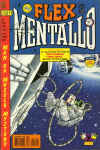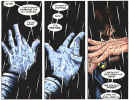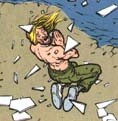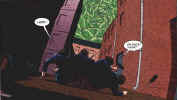
 1.1-2
This image at right--the wet or melting
hand, presented from a first-person p.o.v., recurs in this issue and in
subsequent issues. It comes to represent the "melting"
of identity, between Wally and Flex in particular. 1.3 This is the
acid issue.
1.1-2
This image at right--the wet or melting
hand, presented from a first-person p.o.v., recurs in this issue and in
subsequent issues. It comes to represent the "melting"
of identity, between Wally and Flex in particular. 1.3 This is the
acid issue.
2.2 The goldfish bowl, which pops up in several places and is seen from the inside out in others. The goldfish bowl and the ceramic world of Wally's childhood dreams.
p.2-3 Is it me, or are stripes a major motif in Flex?
p.4 Very Silver Age images...the Silver Age (the 1950's-1960's) was high-concept and in love with the relatively new concepts of science fiction. It is considered the second "Age of Comics," after the Golden Age, which we saw represented in issue one. The phrase "the sinister radioactive residue left behind after the disappearance of the Golden Age Flex Mentallo." indicates there’s more than one, which isn't really that weird in terms of comics. The Superman of the 1930's and 1940's and the Superman of the 1950's on were considered to be two separate beings (from parallel universes) until the 1980's and Crisis on Infinite Earths...but to say more would probably require an annotation all its own.
4.1 Technopolis.. names have a hyperbolic power here. We see "Earth Omega" later.Lamb and Turkey Mentallium, which Wally's cat eats issue 1.
4.5 "escape into the real world…" Flex understands himself as a character from comic books who has emerged into "reality." What is reality in Flex Mentallo, however, is obviously unclear.
5.5 The ceramic town, also known as the fishbowl, where pets are on constant display. "Gnomes watching me undress…" Wally is terrified of being a character, of being watched, read.
 p.
6 Ultra-Violet Mentallium means that
any of us could be Flex without knowing it. Notice that Flex exceeds
the panel in 6.3. Again, Morrison is fooling with our ideas of creator,
character, subject, object. The hand of Flex is also the hand of
Wally on the first page. Endless parallel worlds, infinite versions,
which means that, somewhere, we’re all superheroes…
p.
6 Ultra-Violet Mentallium means that
any of us could be Flex without knowing it. Notice that Flex exceeds
the panel in 6.3. Again, Morrison is fooling with our ideas of creator,
character, subject, object. The hand of Flex is also the hand of
Wally on the first page. Endless parallel worlds, infinite versions,
which means that, somewhere, we’re all superheroes…
p. 7 Notice the flip between panel 1 and panel 3, with facing mirrors inbetween. Wally is a mirror image, a parallel version of himself. Notice also the black space facing Wally in both panels 1 and 3... he is facing "space" just as the Legion of Legions is in panel 4. 7.4: Does this "doesn’t matter if I die" foreshadow the deadly trip of Kamandi on p. 11?
p.8 Wally gives change, just like the mightiest boy in the universe did in issue one, 20.4. These exchanges bring forth relics of better worlds: the crossword, Nanoman and Minimiss in a matchbox.First glimpse of Nanoman and Minimiss, who compose all matter and being. Smaller than we can see, just beyond our view.
10.3-4 This transvestite character resembles Lord Fanny from Morrison's series The Invisibles.
10.3 "Reality--the imaginary story" 10.4 "The Last Boy on Earth" was the nickname of Jack Kirby's Silver Age post-apocalyptic youth hero Kamandi, who was coincidentally a long-haired blond as well. I use the term "Kamandi" to refer to this character throughout the annotation.
 p.12
homage to Crumb and 60’s underground comics?
The style seems very similar to me. And, they are "underground,"
in a subway toilet. Maybe that's stretching it.
p.12
homage to Crumb and 60’s underground comics?
The style seems very similar to me. And, they are "underground,"
in a subway toilet. Maybe that's stretching it.
This page is dense. Panel by panel:
- 12.1: underground comix style a la Crumb
- 12.2: "Reality no more!" Much more cartoony, notice the iconic sound effect behind him.
- 12.3: Adonis, Marvel's Thor
- 12.4: Aerial view. This seems to be Kamandi's new point of view? Note that this is not just Kamandi's hallucination; solo vision is real.
- 12.5-7: X-ray vision
- 12.8: heat vision
- 12.9: close up
- 12.10: a view of infinite earths, a reference to Crisis
- 12.11: This figure could be the old wizard Shazam, mentor of Captain Marvel, sitting at the Rock of Eternity. It could also be God.
- 12.12-14: Fade to white. Could this be "The Absolute", which we see in issue 4?
- 12.15: compare this style of picture to the Fact on the egg in issue one, page 2.
13.5 I really wish I knew what was going on with this panel. Any suggestions?
 14
Kamandi is in a pose of prayer.
14
Kamandi is in a pose of prayer.
15.4 Kamandi's hand in the water corresponds to Flex's and Wally's wet hands.
16: The Golden Age was simply about "homoerotic wish fulfillment," but in the Silver Age the body becomes fluid and takes various shapes. This is, according to Morrison, "a prophecy of the arrival of LSD in America…the comics writers and artists intuited the social transformation in their work." Comic books here are seen as prophetic or even transformative: this kind of faith is necessary to take in the end of issue four. Comics forecast cultural change, affect culture directly. Connections between aliens and super-heroes. "Whose hand am I holding?"
p.18 Clark Kent is here in the bar, as is an accomplice, as is the astronaut who saw the heroes in space. p22 "They walk among us unseen! In secret identities!" Superheroes and conspiracies...is the Legion of Legions any more unbelievable than the Illuminati?
![]() 23
Again, the giving of change brings about "secret knowledge."
This Mystery Pilgrim is one in a line of faceless men in Morrison's work.
Think of the Fact, "Yankee Doodle" (a villain in Doom Patrol).
This character is also strongly analogous to the Charlton/DC hero The
Question.
23
Again, the giving of change brings about "secret knowledge."
This Mystery Pilgrim is one in a line of faceless men in Morrison's work.
Think of the Fact, "Yankee Doodle" (a villain in Doom Patrol).
This character is also strongly analogous to the Charlton/DC hero The
Question.
 24.2
multiple earths, multiple Wallys. Crisis on Infinite Earths: "Next:
Crisis on Earth Omega!" 24.5 An allusion to the move
from the Silver Age to what is considered the "Dark Age."
Lightning at night is a popular image for the next Age; see issue 3 notes.
24.2
multiple earths, multiple Wallys. Crisis on Infinite Earths: "Next:
Crisis on Earth Omega!" 24.5 An allusion to the move
from the Silver Age to what is considered the "Dark Age."
Lightning at night is a popular image for the next Age; see issue 3 notes.
This annotation copyright © 1999-2000 Jason Craft. Flex Mentallo and all images are copyright © 1996 DC Comics/Vertigo.